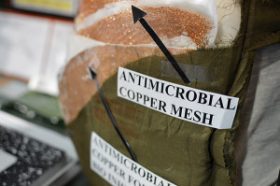A penny for your health?
Teen researchers study copper’s germ-killing prowess
By Sid Perkins

Copper is best known as the reddish metal used to make pennies, electrical wiring and weather vanes. But two teen scientists think copper should find its way into medical settings as well. Their data suggest the metal — in bandages or on surfaces — could play a major role in killing some types of bacteria responsible for serious infections.
Bacteria are everywhere. Some are beneficial. They can help process foods (through fermentation, for example). Many in our gut even aid in digestion. But a large number of bacteria can cause harm. And that’s why antibiotics — germ-killing drugs — play such an important role in medicine today. But for wounds, copper might offer a potent substitute for those drugs, new research shows.
Summer Monroe, 18, has investigated the ability of copper to kill Staphylococcus aureus. These bacteria can live on the skin and in the human respiratory tract (nose, sinuses, throat, airways and lungs), explains the senior at Polk State College Lakeland Collegiate High School in Lakeland, Fla. Most of the time, the bacteria live harmlessly in or on people. But under certain conditions they can cause skin and sinus infections or food poisoning. What’s more, some types of this germ are resistant to the drugs intended to kill them.
But copper holds promise in fighting infections due to this germ, Monroe’s tests show. When she grew S. aureus cells in a glass dish that also held a piece of copper, no germs invaded the area near the metal. Even when the copper was tarnished, or slightly corroded, germs largely refused to invade the area around it.
Building on this observation, Monroe designed a copper-containing bandage for use on the battlefield. Why there? These wounds, including burns, can be massive. They often occur in dangerous regions far from hospitals. And current bandages aren’t designed to fight infection, Monroe explains. They merely cover a wound to help keep out germs.
Monroe’s new bandage is a multi-layered sandwich of gauze and copper mesh. The outermost layer consists of copper foil. It limits the ability of germ-tainted dirt or liquids to enter the wound. It would also limit blood loss, she adds.

Monroe has tested her bandage, but her findings have yet to establish how much this dressing helps. That’s largely because the gauze shed particles of cotton. Those lint particles were almost the same size as the S. aureus cells. So, the instrument she used to count bacteria got confused, counting both germs and stray bits of cotton. In the future, she plans to use different instruments for a more accurate germ count. This would give her a better gauge of how well the bandage kills germs.
Brandon Healey, 16, of Weber High School in Pleasant View, Utah, also studied how copper might fight germs. His research simulated how doctors might use copper in a clinic. For his tests, he compared the germ-killing ability of copper to that of stainless steel. Because it is easy to sterilize — or remove any germs — stainless steel has become one of the most commonly used materials in medical equipment, Healey notes.
In one set of tests, the teen applied different types of bacteria to small pieces of copper and stainless steel. One week later, more than 80 percent of the stainless steel surfaces had growing colonies of germs. But the copper pieces were totally free of germs.
Healey also had patients at a clinic touch or breathe onto pieces of copper and stainless steel. (He tested 100 people, ranging in age from 8 to 65.) He let any germs on the surface grow for 6 days. Afterward, he swabbed each metal plate and transferred any germs it had collected onto a glass dish full of nutrients. There he let any germs grow for another 6 days. By the end, many of the dishes that contained germs taken from the stainless steel still teemed with microbes. Meanwhile, living germs had been extracted and grown from only one of the 100 pieces of copper.
Copper was 99 percent more effective in stopping bacterial growth than stainless steel, Healey concludes. So the reddish metal might help doctors maintain a more sterile environment in their clinics. He says it might also make sense to apply a thin layer of copper to surfaces that people touch often, like doorknobs and countertops.
Monroe and Healey presented their results May 13 in Phoenix, Ariz., at the Intel International Science and Engineering Fair. The Society for Science & the Public, which created the fair in 1950, still runs the competition. (SSP also publishes Science News for Kids.)
Power Words
antibiotics A substance or compound that kills bacteria or slows their growth.
antimicrobial A substance or compound that kills microorganisms (especially bacteria or fungi) or slows their growth.
microbe A microscopic organism. This broad class includes bacteria, fungi and algae.
respiratory tract Parts of the body involved in breathing (also called the respiratory system). It includes the lungs, nose, sinuses, throat and other large airways.
tarnish A thin layer of corrosion that forms on metallic objects. Tarnish often forms when a metal reacts with oxygen in the air, although sometimes other elements can cause the reaction.







